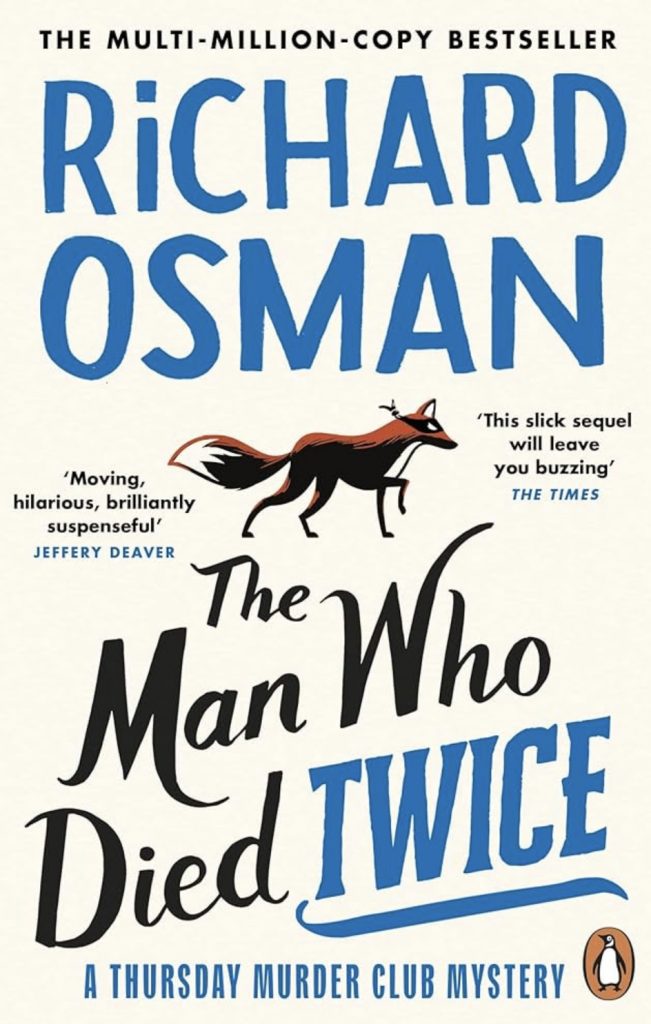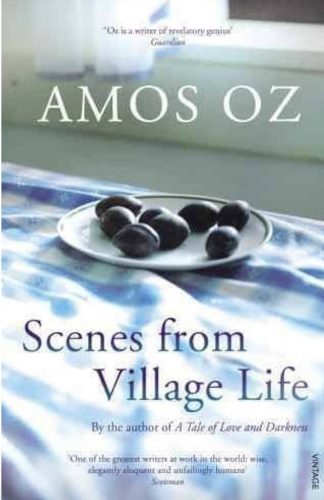
GROUP CONVENOR – Christine Wright
We meet on the first Wednesday of the month at 1.00 pm in the Assembly Room at St Austell Arts Centre. If you enjoy reading and discussing the book you have read, come along and join us.
NB This group is now at capacity. Please contact the Group Convenor via the below form if you would like to be added to a waiting list.
Below are details of our recently read books.
October 2025 – The Man Who Died Twice – Richard Osman

This is the second book in the “Thursday Murder Club” series, possibly conceived by Richard Osman’s visits to his mother’s care home. The club comprises a group of 4 residents from Coopers Chase, a retirement village, who take on and solve crimes using their various skills. The club’s members, Elizabeth, Joyce, Ron, and Ibrahim face a new mystery when Elizabeth’s ex-husband, Douglas (an MI5 agent), moves to a safe house in Coopers Chase. He contacts his former wife, Elizabeth, revealing that he stole £20 million worth of diamonds from the home of Martin Lomax, a middleman for several criminal organisations. The diamonds actually belong to a New York mafioso Frank Andrade and Douglas’s life is threatened as a result. He hopes to get to Antwerp, sell the diamonds, and disappear. He denied his involvement in the theft to MI5.
Ibrahim is robbed and beaten up by a youth named Ryan Baird. The attack leaves Ibrahim frightened and withdrawn. Meanwhile, Detective Chief Inspector Chris Hudson and PC Donna de Freitas attempt to build evidence against a drug dealer Connie Johnson. They question Ryan about the assault on Ibrahim but cannot prove his guilt. The police officers suggest that the Thursday Murder Club could find an alternative way to bring Ryan to justice.
Elizabeth agrees to help Douglas in exchange for information on Ryan. At Elizabeth’s request, her friend Bogdan buys a large quantity of cocaine from Connie Johnson (a known drug dealer) and hands it to Ron. Pretending to be a plumber, Ron plants the cocaine and Ibrahim’s credit card in the tank of Ryan’s toilet. After an “anonymous” call to Donna, Ryan Baird is arrested.
This is only the beginning of the story of what happened to the diamonds and the characters involved…… A story of the intelligence, determination and frailties of getting older, the value of friendship and the coming together of a group of people who still have a lot to offer!
Some comments from the Group:
“I read this book some time ago and, to be honest, I can’t remember a single thing about the plot. What I do remember though (and what I love about this book and the others in the series) is:
- Ibrahim’s fear and feelings of helplessness after being attacked in the street
- Elizabeth’s sorrow at her husband’s advancing dementia
- Joyce’s cheerful “unshockability” and her annoyance at being patronised by her daughter
- The firm friendships between the four main characters, transcending background and class
- Older people using their invisibility in society to get away with all sorts of semi-legal activities
All this wrapped up in a thoroughly entertaining cosy crime mystery.”
“An easy to read James Bondish crime story. I enjoyed the tongue in cheek style and the way he blended high crime into the lives of pensioners living in a retirement village. I thought the character of Joyce was superb and enjoyed reading her diary and of the struggle she had with her relationship with her daughter. There were many touching scenes of normal life of pensioners – The caring of grandchildren at half term, the caring of a loved one with dementia, coping with transport problems, et cetera.
However, there were weaknesses in the plot And if you can’t take them with a pinch of salt, this is definitely not the book for you. The more I reflect on the story the more I like it. I think the title of the book is inspirational. Surely we are expecting Douglas to reappear before the end of the book!
“Not particularly liking Richard Osman, I was delighted by this book which I had heard so much about (the first on and then this). A refreshing venue for a murder story and wonderful contrast in the 4 main characters. The dialogue flows – there is humour and warmth not only in the intricacies of solving murder but particularly the way the characters relate to each other. Osman does not shy away from the facts of old age and sheds a welcome and often hilarious light on the varying personalities and past professions – some of whom reached high levels of ability and intelligence. The sharing between the 4 old friends is beautifully observed, sometimes reminding me of a former group of old friends portrayed in “The Best Marigold Hotel”.
“I found it quite hard to review as a stand-alone story as I have read all 4 of the Thursday Murder Club mysteries and seen the film. I can hear Richard Osman’s voice telling the story – he assumes you have read the first book and you know the characters. The storyline is long-winded and complicated and there are several twists at the end. However, I really enjoyed it and laughed out loud!”
“The book is very eloquently written with a good smattering of humour. We learn the interesting backgrounds of the characters and how each, with their varying skills and personalities, makes a valuable contribution to the whole, a former MI5 member, a nurse and a psychiatrist. As the plot unfolds, Elizabeth discovers a letter from Douglas and manages to solve the code within which leads to the discovery of the diamonds. The conclusion is good for the Thursday Murder Club and they are ready for their next adventure!”
“I started reading this book enjoying the fluid writing style and the jokiness and fun description of the characters but after the first 50 pages I tired of the vacuous nature of the story emerging. It no longer gripped me and I struggled to read it. The laddish albeit clever humour was repetitive and boring. Pointless by association and pointless by nature. Richard Osman is amusing in small doses and clearly has a popular following I can take or leave him in small measure!”
September 2025 – Scenes from Village Life – Amos Oz

This is a collection of short stories from an Israeli writer about the people who live in a small village in Israel called Tel Ilan. Each story provides a glimpse into their lives and dreams and what often lies beneath the outward veneer. Each one stands alone although some of the characters sometimes appear in others’ stories.
This was a difficult book to make sense of but I don’t think we are meant to – it’s about the outward appearance of people and what lies hidden beneath the façade. An intriguing book, reminiscent of Kafka. It is no surprise that Oz won the Franz Kafka Prize for Literature in 2013 – a prize which “honours authors whose work transcends cultural and national standards”.
Comments from members of the group:
“A stranger turns up at a house and persuades the owner, Zelnick, (to murder his mother?) whose presence is preventing him from selling the house and moving on with his life; Gili, the family doctor waits for her nephew who is not on the bus as expected – she is clearly in love with him and is distraught that he has not arrived; an old man hears digging under his room in the middle of the night; a teenager’s love and angst for an older woman; a man who waits for his wife who has left a note ”Don’t worry about me” and does not realise she has left him – or why; a man wanting to buy a house and mesmerised by the owner Yardena; a man drawn to the bedroom of a house he is visiting where the son committed suicide underneath his parents’ bed – and they slept in the room unaware of his body beneath them. The last story “In a faraway place at another time” could be the village as it is in the future where evil has prevailed in a god-forsaken place. Who knows? I’m still not sure whether or not I enjoyed it!”
“As a portrayal of different characters, I thought this book was well written. I would, however quibble over a village of any size having a mayor and council officers.
The reader is only allowed a glimpse of each character’s life, the outcome being left to our imagination. Personally, I found this frustrating. Did Ariel and Wolff get away with murder? What had happened to Gillis nephew? There was something about each character we wanted to know more about. I was expecting an outcome in the final chapter and felt let down when this did not happen.
If there was a deeper meaning behind the story, I’m afraid I didn’t get it!”
“This village did not seem to be a village as it appeared to be bigger and have more facilities that you would expect from a village. More Par than Tywardreath. No-one Amos Oz described was happy. The writing was very descriptive and evocative but not like somewhere I would want to live. It felt like everything was in shades of grey.
I found the ending of the first story “Heirs” quite disturbing. I decided it must be some sort of allegory for the situation with the land occupied by the Jews and the insecurity of the people who live there. There was an uneasiness. It takes place at the house of Arieh Zelnick Though why the Arab should be caressing the elderly mother’s face I could not fathom. It had a rather dreamlike quality.
The second story, Relations was an aunt, Dr Gili Steiner waiting for her adult nephew to arrive on a bus. He doesn’t arrive. We don’t find out why. Their relationship seems to be troubled. There is a feeling of loneliness, loss and longing. Quite a long story for nothing to happen.
The third story Digging is about a middle-aged daughter Rachel Franco living with her elderly father who thinks he can hear digging under the house. In the end she can hear digging under the house as well. There is a young Arab student, Adel, living on their land. The relationship between them is one of distrust from the father but they have an interdependence and the boy sings for them when asked. A feeling of unease, dissatisfaction, loneliness, hopelessness.
The fourth story “Lost” is about an estate agent who would like to buy a particular house and then he seems divided between living in it or pulling it down. He eventually calls at the house without notice and finds a young girl there, the niece of the elderly owner. The young girl shows him round and there is a very odd kind of flirtation between them which seems inappropriate. Bizarrely she eventually leaves him in the cellar where he appears to be in a comatose trance. It must surely be symbolic for something but I have no idea what.
Waiting. In this story Adel appears again. He brings a note to the Mayor, Benny Avri. The note is from the Mayor’s wife saying, “Don’t worry about me”. That’s it. The rest of the story concerns the mayor finding his wife is not at home and wandering around looking for her in a desultory way. He doesn’t summon help or report her missing he just wanders around. Sits on the bench where she was last seen and waits for her. For no discernible reason a dog starts following him. He doesn’t seem to know whether he wants to stroke its head or chase it away. Their marriage sounds rather dull. We don’t find out what happened to her. The only clue is that his wife, Nava, was pressured into having an abortion before they were married.
Strangers: This story is equally miserable. A boy with a crush on the postmistress, an older woman, Ada Dvash. Both of them unhappy and lonely. An awkward encounter between them in the library. This puts an end to their uneasy friendship as he basically sexually assaults her.
Singing. Written in the first person. The writer? He describes himself as a confirmed bachelor Some characters from other stories appear. A party at the house of Avraham and Dalia Levin. A couple whose only son commits suicide under their bed. Macabre as they don’t realise he is there. It describes their miserable lives. Then introduces a new character Dafna Katz. Dr Gili Steiner is there – she was waiting for her nephew in Relations; Rachel (from Digging) and Arieh Zelnik (from Heirs) arrive together or at the same time. Etty is mentioned (she was mentioned once in Lost) – apparently the wife of the estate agent. In that story he says she may be trying to phone him.
I thought this story might draw everything together and make some sense or give some closure to the other stories but instead it becomes more bizarre as while the party continues the speaker goes upstairs to the abandoned bedroom and gets down onthe floor presumably intending to get under the bed were the son of the hosts committed suicide. Why and what this means I have no idea. There is talk about bombing raids and the politics of this amongst the guests but this too leaves me wondering what I am supposed to conclude.
The last story I could not understand at all. Seemed to be a scene of hell. Was it still the village but in another era?”
A collection of connected short stories but stories that are unusually Incomplete in as much as any action or thought processes of the characters are inconclusive. One is left high and dry wanting an outcome. However, the descriptions of homes, landscapes and peoples have a breadth and beauty that is very engaging. Eg the “digging “story involves a widow who lives with her difficult dad who is obsessed by the noise of someone digging underneath their dwelling. The daughter tells her dad it is his bad conscience. Overall, the conclusion infers the village is an inhospitable swamp. Singing is better than getting worked up about politics. It drowns out the sound of the bombs. Yes, the final powerful tale is very bleak and depressing. But the beauty of the translated prose is exceptional. I was tempted to reread to understand perhaps more about the books intention particularly relevant to the ongoing horrors of Gaza and the Israeli situation.”
“The prose is really descriptive and you get a clear and vivid picture of the characters and their everyday lives and routines but each tale has a strange event, a mystery and at the end, the character is waiting…. that is never fully explained. The stories stand alone but the characters appear in others’. It is like a soap opera. The final chapter is very strange – a description of madness, perhaps a prophecy of how remote villages will become if they have no contact with the outside world. I liked this book there is so much detail and I would read it again.”
“I liked the way the author left much to the reader’s imagination by the strangely loose connections with the characters in the stories. Extraordinarily intense beautiful writing describing feelings and thoughts in the ordinary lives of folk living in Tel Ilan. This reminded me of the wonderful “Under Milk Wood” by Dylan Thomas. There was a sense of poetic mystery in each chapter – I particularly liked “Waiting” – an elderly mayor looking for his wife around the village not realising that she has walked out on him. The last chapter is a faraway place in another time and prophetically describes a nightmare vision of a village gone mad and mad – it is very sad. The pharmacist could almost be describing some of recent scenes in war-ravaged Gaza.”
Previous Reviews can be seen HERE
We are happy for you to come to a Coffee Morning or one main Monthly Meeting and to attend one individual group (with the exception of groups that require pre-booking and ticket purchases) before deciding whether to join St Austell u3a.
Please always contact the Group Convenor to ensure the session is going ahead.

